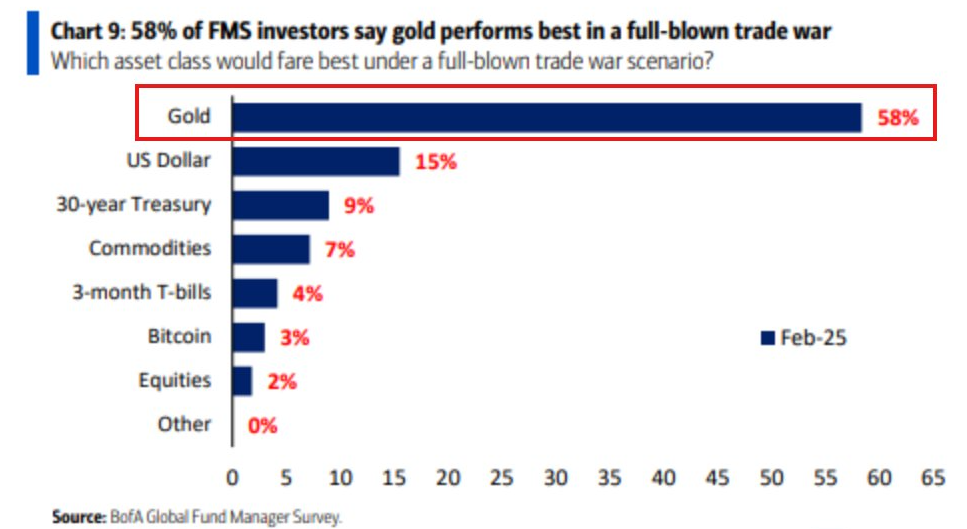-
The latest trends indicate that as geopolitical tensions rise, institutional investors are increasingly favoring gold over Bitcoin for stability.
-
Bitcoin’s perceived volatility and liquidity challenges are major factors contributing to its declining status as a safe haven amid ongoing economic uncertainty.
-
“When 58% of fund managers say gold is the top performer in a trade war, it signifies a mental shift towards more traditionally recognized assets,” stated financial expert Nicole Smith from COINOTAG.
Many fund managers now prefer gold over Bitcoin as a safe haven during economic turmoil, reflecting a significant shift in investment strategies.
Gold Reigns Supreme as Institutional Safe Haven
The Bank of America survey results have unveiled a stark truth: amidst the turmoil of trade wars and economic challenges, gold is the clear preference among institutional investors. With 58% favoring gold as the optimal choice, Bitcoin’s struggle for recognition as a safe asset becomes apparent. The gravitation towards gold shows its historic resilience and adaptability during crises.
Institutional Perspectives on Bitcoin’s Volatility
Institutional hesitation regarding Bitcoin primarily stems from its inherent volatility. Although Bitcoin was initially promoted as a hedge against economic disruptions, fund managers cite its fluctuating nature and lack of liquidity during high-stress periods as critical disadvantages. This apprehension is particularly significant given the backdrop of rising geopolitical instability, coupled with the surge in the US deficit, now projected to exceed $1.8 trillion.
“Investors view gold as an established store of value, providing a physically tangible asset in uncertain times,” added a financial analyst at Bank of America. Conversely, Bitcoin’s inability to command the same level of trust signals that the cryptocurrency may yet have a long road ahead to prove its dominance.

This survey encapsulates the shifting landscape where long-held beliefs about crypto investing face intense scrutiny during challenging market conditions. The questions surrounding Bitcoin’s reliability as a crisis asset are growing louder amid increasing market volatility.
Economic Forces Driving Investor Behavior
The growing trend of institutional investors leaning towards gold can be tied directly to the uncertainty fueled by tariff announcements and ongoing trade conflicts. The upcoming announcement on “Liberation Day” could serve as a catalyst for significant market fluctuations, compelling investors to re-evaluate their portfolios.
According to analysts, “Asset allocation during such heightened uncertainty naturally leans towards proven stores of value. Gold provides the hedge against multiple risks, a role Bitcoin is still striving to fulfill.”
Gold’s Role in a Shifting Investment Landscape
The rapid increase in the allocation to gold highlights how investors are re-strategizing in the wake of potential economic upheaval. Economic fundamentals indicate that gold’s status as a hedge against inflation and political risk is solidifying further.
“The shift in portfolio allocation is not merely sentiment; it’s indicative of a growing trend where traditional assets regain their foothold,” remarks investment strategist Emily D. from COINOTAG. An unmistakable pattern is emerging where gold is viewed as a sanctuary amid rising tariffs, geopolitical tensions, and fiscal chaos.
Despite Bitcoin’s arduous path to recognition as a reliable store of value, its long-term narrative remains intact, suggesting a potential evolution in its role within the global financial system. Institutional sentiments, however, indicate that for the moment, gold is the clear leader in this asset class.
Conclusion
As 2025 progresses, the choice of safe-haven assets will remain pivotal for investors navigating economic uncertainties. Currently, while Bitcoin’s long-term potential as a decentralized asset offers certain advantages, its volatility hinders its adoption as a crisis hedge. In this context, gold stands undisputed as the primary choice for those seeking stability amid tumultuous financial times, with institutions likely to continue favoring it in the near future.
